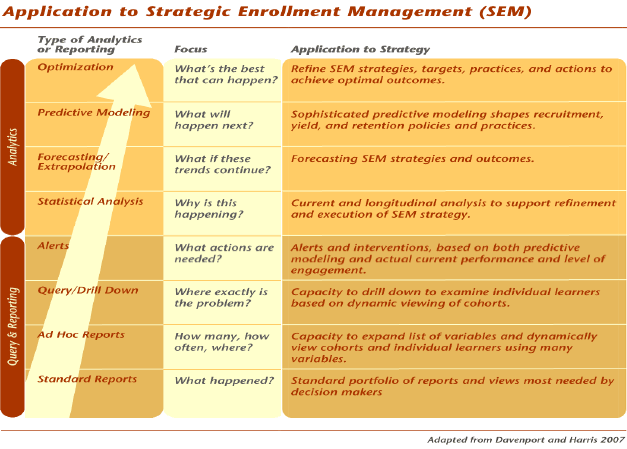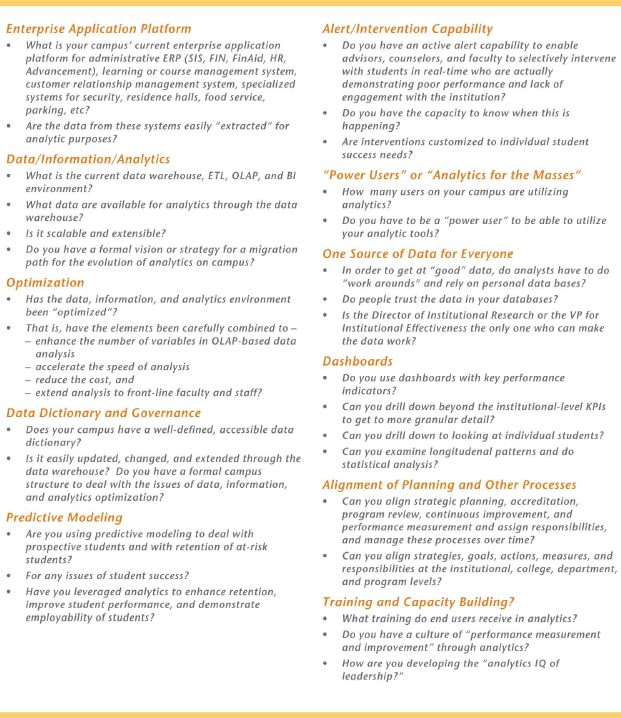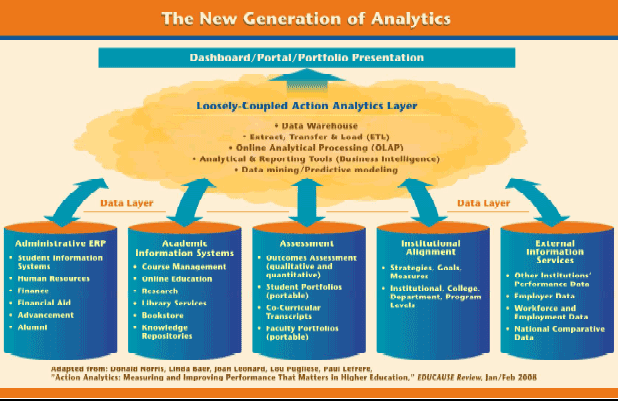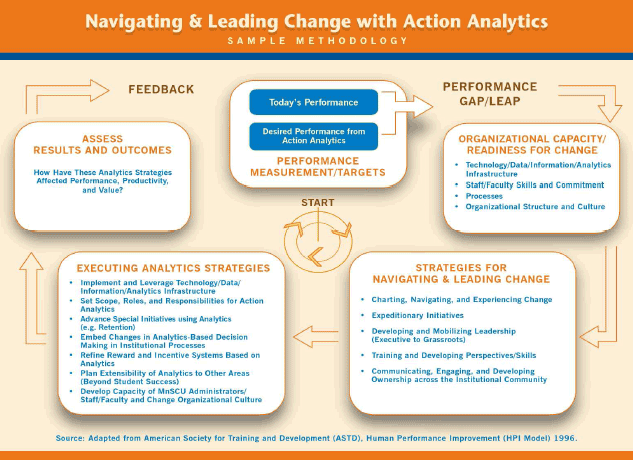Date created: September 18, 2008
Author: Donald M. Norris, Strategic Initiatives, Inc.
For further information, contact the author at Strategic Initiatives, Inc.
Phone: 703.450.5255
Web: www.strategicinitiatives.com
E-mail: dmn@strategicinitiatives.com
SEM Is Based on Analytics
Strategic Enrollment Management (SEM) depends on metrics and analytics for success. Leading-edge SEM consulting services provided by firms like SEM WORKS address this issue. They include an assessment of the institution's data/information/analytics resources and their capacity to utilize these resources to enhance student access, affordability and success. These services also include infrastructure development and capacity building services to enhance analytics capabilities and raise the "analytics IQ" of campus leadership.
Leveraging Analytics for Competitive Advantage. In their book, Competing on Analytics, Davenport and Harris identified a typology of query, reporting, and analytics capabilities that organizations can use to improve performance and competitive position. Figure 1 illustrates how these capabilities can be deployed to support strategic enrollment management.
Figure 1

Many institutions are using combinations of predictive modeling and statistical analysis to recruit, improve the performance of their admissions funnel, and design programs and policies to improve retention. Some are utilizing predictive modeling, queries and alerts to intervene with at risk students. These practices are described in an excellent, recent article in the EDUCAUSE Review (Campbell, John P. Peter P. DeBlois, and Diana G. Oblinger, "Academic Analytics: A New Tool for a New Era," EDUCAUSE Review, July/August 2007). For institutions lacking these capabilities, many of the SEM consulting firms provide assessment and analytic services.
A "Swiss Cheese" Infrastructure for Data, Information, and Analytics. In assessing institutional capabilities using the Davenport/Harris framework of reporting, query, and analytics, Strategic Initiatives has found many institutions that have deployed sophisticated predictive modeling and analysis have serious issues with their underlying data and information infrastructures. So they can deploy predictive modeling for specially selected cohorts of students, but cannot drill down into their data bases to identify at-risk students based not just on demographics but on actual, current engagement and performance. The data, information, and analytics capacity of these institutions in like a piece of Swiss cheese. The holes must be filled or bridged if the institutions are to optimize their use of analytics in strategic enrollment management.
Data, Data Everywhere - Hiding in Plain Sight. Most colleges and universities are awash in data. Unfortunately, they lack the capacity to seamlessly turn their data into meaningful information. Nor can they easily access, combine, and repurpose that information to support analysis, drive decision making, and improve student success. In many cases, the data they need are hiding in plain sight. They are frozen in place by sub-optimized data models (i.e., either complex ERP databases or inflexible data warehouse designs), by difficult-to-use reporting tools, and/or by the proprietary nature of some systems. Rather than crafting analytical applications that create optimized data, information, and analysis environments, many colleges and universities have focused on individual analytic tools, with disappointing results.
Optimizing Data/Information/Analytics Environments
The Davenport/Harris model implies a sort of hierarchy, where analytics deliver more competitive punch than query/reporting. In reality, optimized data/information environments enable optimized combinations of data mapping, data warehouse (DW), extract transfer and load (ETL), online analytical processing (OLAP), and business intelligence (BI) capabilities that are very powerful in identifying, alerting, and intervening with at-risk students. These optimized capabilities provide intuitive, easy-to-use tools that can be used not just by power users (tools like SAS, Hyperion, Cognos and the like require mastery of prototcols unless embedded in an analytic application that is user friendly) but by front-line enrollment management workers. OLAP capabilities enable these workers to dynamically change the combinations of variables being used. Analytic applications enable institutions to move from a culture of reporting to one of dynamic viewing.
This new wave of analytic applications (not just tools) is now available in three modes: 1) Build your own (typically using data warehouse firms), 2) develop the application in partnership with your ERP vendor, or 3) buy a pre-packaged application that can be rapidly deployed and tailored to your needs. These options are described in our White Paper, "What Every Campus Leader Needs to Know about Analytics," which can be accessed at the following url address: http://www.strategicinitiatives.com/documents/know_about_analytics.pdf.
Figure 2 portrays the sets of questions that can be asked to assess the analytics environment of institutions in assessing the nature of their data, information, and analytics environment. Many institutions find they must solve these data and information issues before moving on to analytics.
Figure 2
Your Current Analytic Environment Checklist

Envisioning the Future - Action Analytics™
Optimizing the data, information, and analytics ecology is necessary to optimize SEM and other institutional processes – strategic planning, accreditation, continuous improvement, performance evaluation, and so forth. As discussed in the previous section, leading-edge institutions are addressing these issues by assessing their current environments and building or buying sophisticated analytic applications to address key institutional performance issues. These applications are part of a new generation of applications which my colleagues and I have defined as action analytics™, where analytics don't just enable decision making, they literally demand action to enhance performance.
We have detailed the dimensions of these new analytics in "Action Analytics: Measuring and Improving Performance That Matter in Higher Education" (Norris, Donald, Linda Baer, Joan Leonard, Lou Pugliese, Paul Lefrere, "Action Analytics: Measuring and Improving Performance That Matters," EDUCAUSE Review, Jan/Feb 2008). Figure 3 portrays its elements:
- a presentation layer combining dashboard, portal, and portfolio capabilities;
- a loosely-coupled analytics layer combining data mapping, DW, ETL, OLAP, and BI as discussed earlier; and
- a layer of data "buckets" so analytics can easily extract data to the data warehouse from administrative ERP, academic information systems, assessment, institutional alignment, and external information sources.
Increasingly open-architecture configurations will enable decision makers to scrape and combine data and information from these different buckets.
Figure 3

Today's analytic applications are on a migration path to the action analytics of the future. The challenges for SEM decision makers and institutional leadership in general are to:
- make sound decisions today to optimize data, information, and analytic environments,
- deploy analytic applications that can improve student access, affordability., and success and enhance institutional competitive stranding;
- chart migration paths for action analytics capabilities of the future (don't paint your institution into a corner;
- build the institution's capacity to create a culture of performance measurement and improvement; and
- change the behavior of decision makers at all levels, starting with strategic enrollment management processes, but moving on to other processes.
These steps are necessary to move beyond a culture of evidence to a culture of performance.
Building a Culture of Performance
Action analytics is a broad-scale organizational development challenge. It is also a campaign that can take three to five years to genuinely change decision making behavior and performance in strategic enrollment management and other institutional decision-making processes.. Typically, achieving optimized action analytics begins with technology, data, and analytics infrastructures and applications. But the critical long-term successes will be realized only through:
- improving institutional processes using data to drive decision making (e.g., strategic enrollment management, strategic planning, accreditation, continuous improvement, and academic innovation);
- developing fresh competencies and perspectives for administrators, staff, faculty, and other users involved in those processes; and
- changing organizational cultures, rewards, and behaviors.
Strategic Initiatives, Inc. has proven approaches to creating action analytics and enhancing performance cultures in colleges, universities, and other settings. We have literally written the book on leading and navigating change in colleges and universities – A Guide to Planning for Change (Donald M. Norris and Nick L. Poulton, Society for College and University Planning, 2008). Figure 4 illustrates our approach to leading and navigating change with action analytics. This approach enables institutions to:
- articulate the performance leaps they expect from leveraging analytics,
- define their readiness for change, barriers to be overcome, and ways in which their organizational capacity needs to be developed in data/information/analytics capacity, decision-making processes, skill and perspectives of staff/administrators/faculty users and organizational culture;
- Strategies for leading and navigating change;
- Executing analytics strategies; and
- Assessing results and outcomes and feeding back to performance targets.
These approaches assure solid migration paths.
Figure 4




